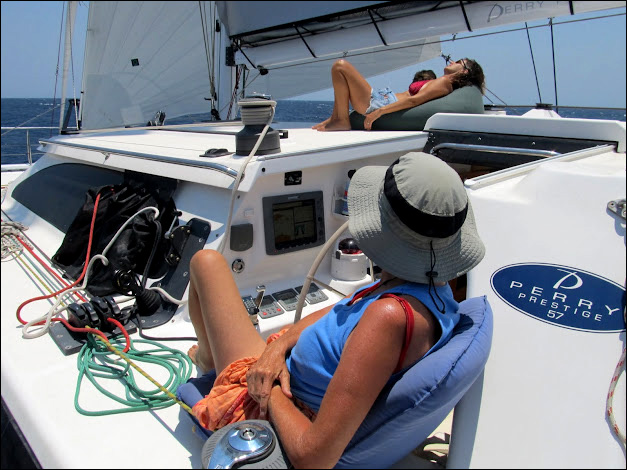 |
| Gwen at the helm, owner on the beanbag |
When a long passage looms, many cruisers begin thinking about whether or not to take on crew to help. What pops promptly into our heads are the shorter watches that having extra crew enables. How seductive that idea of lying abed for more than two hours at a stretch! Maybe, even… together?! Uh, huh! But like most great ideas, taking crew aboard your boat is an issue with many facets worth considering closely. And the same is true for those crewing.
Don and I weren’t the only ones crewing aboard boats in the Sail Indonesia Rally. There was the monohull with a gal who’d crewed for the owners several previous times in the Pacific (whom we’d first met in Fiji) – a happy situation. There was the catamaran with a whole second family aboard; were they guests or crew? There was the midlife-skippered trawler with a bevy of free-spirited babes; hmm? And there was the couple stuck with an indigent sailor they’d taken on back in Trinidad.
What does it mean to be “crew”?
The label applies to many different actual situations. Is “crew” anyone who is not the captain? Or does it include all aboard, working together as a team? Most cruisers use it both ways, even when talking about a vessel’s basic complement of husband and wife!
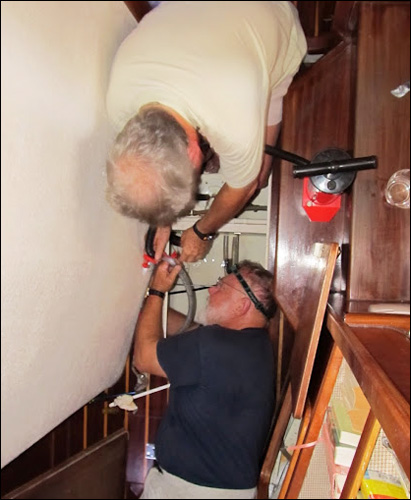 |
| Maintenance |
But on a cruising boat there are different niches a body can fill. I’ve seen paid crew, paying crew, passengers and guests, and from each is expected a different level of contribution, while, in turn, to each is owed a different level of accommodation. Not everybody, of course, gets what they expect, but everybody should go in with their eyes open to both the plusses and minuses.
For longer trips, the most common cruising crew situation seems to be a sharing scenario, where the crewpersons joining pay personal expenses, share food costs, and pitch in like family on everything that needs doing. In return they get an experience they would otherwise not be able to have. This was the basis for all three of Don’s and my crew situations in Indonesia.
There are many advantages to having spare hands along on a long trip. In addition to shorter and less frequent watches (meaning everyone gets more sleep), there’s the comfort of knowing that, should one of you become ill or injured, your partner won’t have to manage alone. There’s help on deck with sail changes, the downwind pole or spinnaker, getting anchors up or down or launching the dinghy. Likewise, basic chores like cooking, dishwashing and everyday maintenance can be shared.
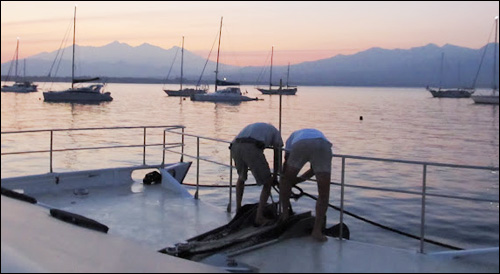 |
| Getting the anchor up |
Plus, when it comes to troubleshooting in remote areas or out at sea, more heads are better than one. When the mainsheet traveler car on Quantum Leap snapped departing Timor, Don was able to help Tom devise a fix that served for six weeks. And should crew come with special skills (such as a gift with languages or Don’s watermaker tech background) – it can be quite an asset.
In addition to physical help, having crew can enhance the experience by bringing new perspectives, making shared experiences and conversations more fun and interactive, even pushing each other to do more, such as our presence on Quantum Leap motivating our hosts to get back into scuba diving. Plus, when in port making trips ashore, there’s someone extra to stay behind and watch the boat, as we did for Quantum Leap and Dedalus in Bali.
From the crewpersons’ point of view, the advantages are obvious.
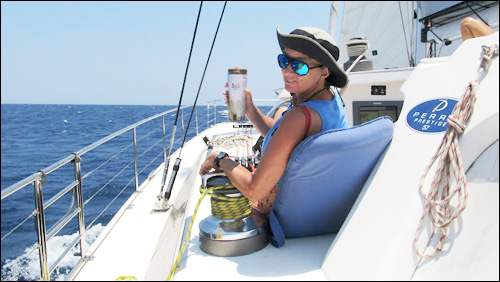 |
| From the crewpersons’ point of view, the advantages are obvious. |
Quite simply you get to do something you wouldn’t otherwise be able to do – whether it is the sailing itself, the places you visit, or the experience of a certain kind of boat – without the investment in the boat yourself! And afterwards, as Don likes to say, when the boat goes to the yard, you go to the airport!
When you are new to cruising, crewing can be an unmatchable learning opportunity.
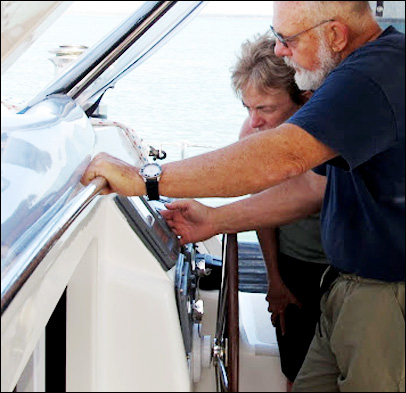 |
| I was able to show the captain several functions he didn’t know about on his chartplotter |
If you already have some miles under your belt, it feels great to get out there and contribute, to exercise skills and share what you know, even while getting the chance to learn how other people do things, use different equipment, or experience a very different kind of sailing. (Even as I learned about multihulls, I was able to show the captain several functions he didn’t know about on his chartplotter.)
Furthermore, as we discovered, meeting new people along the way can lead to more opportunities.
For crewing situations to work, both parties need to do their part, but also recognize what compromises have to be made.
Sharing a space as confined and personal as a cruising boat is not always going to be a bed of roses whether you are the share-er or the share-ee!
For the owners, the boat is not just a vessel but a home filled with personal possessions and defined by personal ways of doing things. Bringing outsiders into the mix not only halves personal space but exposes you to compromises over itinerary, menus, and activities. Practically speaking, the finite resources of the boat – sleeping and storage space, foodstuffs and water… even battery power – will become taxed, laundry and trash will double, and each person’s threshold of “shipshape” may well be different.
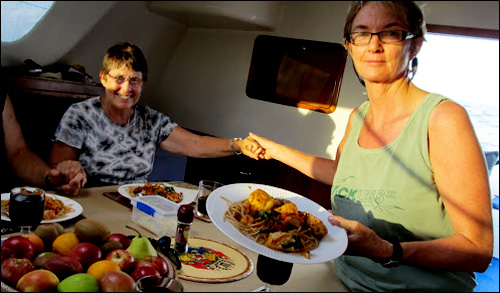 |
| Sharing meals |
Even when crew are known friends – but definitely when strangers – there can be issues of trust, which is, in the final analysis, the cost of those extra hours of shut-eye. Ivory Street’s captain was taken aback to come on watch and find his crew (before us) flying the spinnaker in winds well beyond when it should have come down. He couldn’t sleep the same afterwards.
Owners and crew may bump heads over the way everyday things are done, from anchoring to washing dishes. Owners may sometimes feel second-guessed, criticized or challenged, phenomena that become, ironically, more likely the more knowledgeable and experienced your crew is! From the crew’s point of view, you must bow to not doing things your way. Indeed, good crew strive to stay conscious at all times of keeping to their hosts’ standards and practices.
There are things both owners and crew can do to make the situation work for everyone.
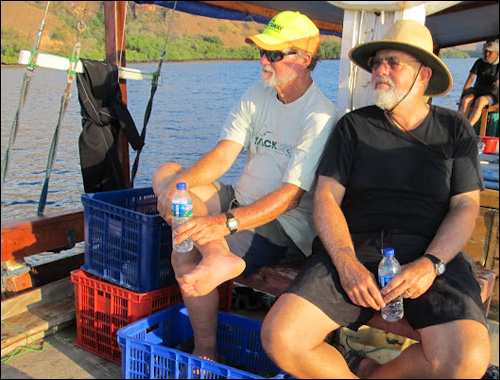 |
| Aim to match yourselves up by compatibility, shared interests, and complementary attitudes and styles |
First, aim to match yourselves up by compatibility, shared interests, and complementary attitudes and styles.
As crew, be sure you are comfortable with the boat’s condition, systems and space as well as with the voyage’s planned schedule and pace before you sign on. Be sure your own schedule is open.
Then, the captain must act as captain, making clear from the outset the way things are done whether it’s reefing a sail, washing dishes or flushing toilets. You can’t expect crew to follow protocol if they don’t know what the protocols are. However, a captain must never take unfair advantage of crew nor forget who is ultimately responsible.
And speaking of responsibility, both parties need to remember that the skipper of a boat is liable for the health and welfare of all aboard and cannot simply put someone ashore when things don’t work out.
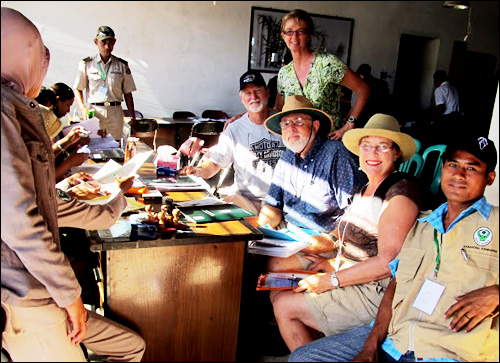 |
| Skipper’s responsibilities: you bring them in, you have to get them out |
For most countries, you bring them in, you have to get them out. In most situations, as in ours, this is a gentleman’s understanding.
However when South African friends took on their countryman in Trinidad, they understood he had his own means to contribute to provisioning, buy meals and clothes, pay for doctor visits and fly home when the time came. It did not turn out to be the case. They were stuck with him until they could repatriate him halfway around the world.
This article was published in the February 2012 issue of Latitudes and Attitudes.
Related articles on this website
- Guests Aboard (Admiral’s Angle column #40)
Some counsel about managing visits and visitors to enhance their experience and maintain crew sanity. - Single Women Sailing – Part 1 (Admiral’s Angle column #27)
Ways to get into sailing when you are single - Single Women Sailing – Part 2 (Admiral’s Angle column #28)
Perspectives on owning and operating your own boat
